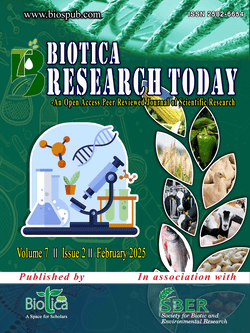
Health and Environmental Risks of Microplastics in Shrimp Ponds
Dhinesh P.*
Dept. of Aquatic Animal Health Management, Tamil Nadu Dr. J. Jayalalithaa Fisheries University, Dr. M.G.R. Fisheries College and Research Institute, Ponneri, Tamil Nadu (601 204), India
Navin Kumar D.
Dept. of Aquatic Animal Health Management, Tamil Nadu Dr. J. Jayalalithaa Fisheries University, Dr. M.G.R. Fisheries College and Research Institute, Ponneri, Tamil Nadu (601 204), India
Porselvan S.
Dept. of Aquatic Animal Health Management, Tamil Nadu Dr. J. Jayalalithaa Fisheries University, Dr. M.G.R. Fisheries College and Research Institute, Ponneri, Tamil Nadu (601 204), India
Kaviarasu D.
Dept. of Aquatic Animal Health Management, Tamil Nadu Dr. J. Jayalalithaa Fisheries University, Dr. M.G.R. Fisheries College and Research Institute, Ponneri, Tamil Nadu (601 204), India
Saravanan S.
Dept. of Aquatic Animal Health Management, Tamil Nadu Dr. J. Jayalalithaa Fisheries University, Dr. M.G.R. Fisheries College and Research Institute, Ponneri, Tamil Nadu (601 204), India
DOI: NIL
Keywords: Aquatic animal health, Microplastics, Plastic pollution, Shrimp farming
Abstract
Microplastics (MPs) are tiny plastic particles resulting from the degradation of larger plastics or commercial production of plastic materials, pose significant environmental and ecological threats. In shrimp farming, MPs originate from plastic equipment used in aquaculture and from external sources such as polluted water. The microplastics that are present in the shrimp pond may affects the shrimp health, which may lead to several health issues like digestive issues, abnormal swimming behaviours, oxidative stress, increase the vulnerability of disease and reproductive challenges in the shrimp. These microplastics disturb the shrimp population as they are primarily deposited in the intestinal tracts and hepatopancreas of the shrimps. The most abundant microplastic in the shrimp pond is microfibers and polyethylene. To solve this issue, healthy aquaculture techniques and initiatives to limit plastic pollution are required. Further investigation is needed to determine the long-term effects of MPs on aquatic ecosystems and identify suitable mitigation strategies.
Downloads
not found
Reference
Azizah, P., Ridlo, A., Suryono, C.A., 2020. Mikroplastik pada Sedimen di Pantai Kartini Kabupaten Jepara Jawa Tengah. Journal of Marine Research 9(3), 326-332. DOI: https://doi.org/10.14710/jmr.v9i3.28197.
Browne, M.A., Galloway, T., Thompson, R., 2007 Microplastic - An emerging contaminant of potential concern? Integrated Environmental Assessment and Management 3(4), 559-561. DOI: https://doi.org/10.1002/ieam.5630030412.
Lusher, A.L., Mchugh, M., Thompson, R.C., 2013. Occurrence of microplastics in the gastrointestinal tract of pelagic and demersal fish from the English Channel. Marine Pollution Bulletin 67(1-2), 94-99. DOI: https://doi.org/10.1016/j.marpolbul.2012.11.028.
Mattsson, K., Ekstrand, E., Granberg, M., Hassellov, M., Magnusson, K., 2022. Comparison of pre-treatment methods and heavy density liquids to optimize microplastic extraction from natural marine sediments. Scientific Reports 12, 15459. DOI: https://doi.org/10.1038/s41598-022-19623-5.
Zhu, F., Zhu, C., Wang, C., Gu, C., 2019. Occurrence and ecological impacts of microplastics in soil systems: A review. Bulletin of Environmental Contamination and Toxicology 102, 741-749. DOI: https://doi.org/10.1007/s00128-019-02623-z.
